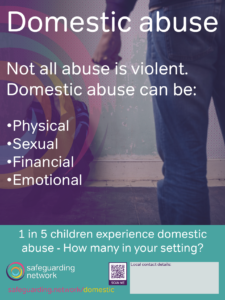Impact on children and young people
Children are suffering multiple physical and mental health consequences as a result of exposure to domestic abuse. Children see parents or carers suffer, often at the hands of someone else they love. They suffer physical, sexual and emotional abuse themselves. Sometimes they are forced into colluding with the violent partner; sometimes they feel deeply responsible for the non-abusing parent or carer, or for their brothers and sisters. Children can be further affected when adult victims of domestic abuse sometimes find it difficult to be the caring, supportive parents they would want to be, even after leaving the abusive relationship, because they have been hurt and traumatised by their experiences.
Amongst other impacts, over half (52%) had behavioural problems, over a third (39%) had difficulties adjusting at school, and nearly two-thirds (60%) felt responsible for negative events. A quarter of both boys and girls exposed to domestic abuse exhibit abusive behaviours themselves and children were more likely to show abusive behaviours after exposure to the domestic abuse had ended.
In relationships where there is domestic violence, children witness about three-quarters of the abusive incidents. About half the children in such families have themselves been badly hit or beaten. Sexual abuse and emotional abuse are also more likely to happen in these families.







